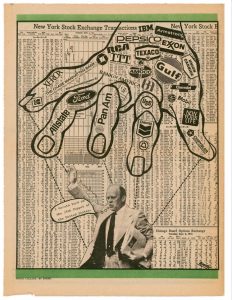Back in May, i was in Geneva to attend the Forum Paradigm_Shift #2. The event, which was part of the audiovisual and digital art festival Mapping, investigated the theme “Humans + Machines by Design, not by Default”.
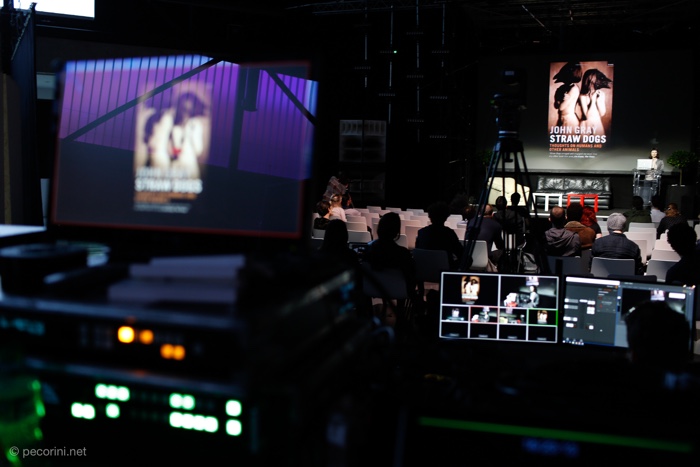 Forum Paradigm_Shift, Mapping Festival 2018 at HEAD Genève – Nouveau Campus. Photo (c) Stéphane Pecorini
Forum Paradigm_Shift, Mapping Festival 2018 at HEAD Genève – Nouveau Campus. Photo (c) Stéphane Pecorini
The artists, designers, curators, scientists and philosophers invited delved into technodiversity, contemporary utopias and dystopias, the future of money, Glitch Feminism and cultural resistance, and the human-technology relationship from an artistic, philosophical and scientific point of view. This program, which had been curated by Carmen Salas, might sound a bit haphazard but it made for an exhilarating and thought-provoking day. Each of the speakers challenged, in their own way, dominant discourses around progress, technology, future and hybridity.
The videos of the keynotes and panels are online. Check them out because they build up a much-needed picture of some of the ethical and cultural reflections that surround digital technology today.
1. Cash is not dead
Cash or Cache: What is your money saying about you – Paradigm_Shift #2 Forum – Mapping Festival 2018
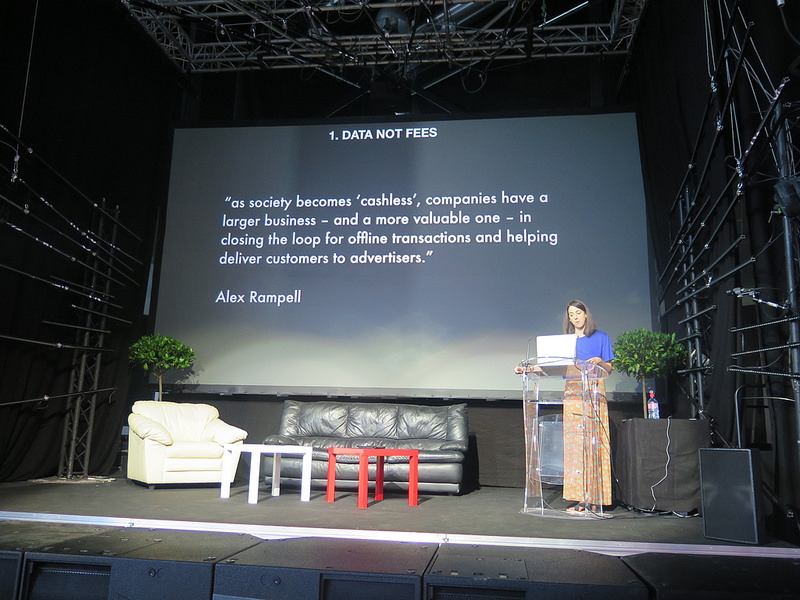
Rachel O’Dwyer at Paradigm Shift, Mapping Festival in Geneva
Rachel O’Dwyer‘s presentation Cash or Cache: What is your money saying about you? dissected the emerging politics around transactional data. She explained how the push for a cashless society on the part of states and platforms is creating new forms of business models based on data, not fees. Which of course entails new forms of discrimination and of surveillance but also new practices of resistance. Her talk was fascinating. I was particularly interested in her comments about how cash, though it doesn’t record traces of transactions anymore, can teach us a lot about the way paper money mediates social relationships as it moves from hand to hand. I liked the research made by Dirk Brockmann, a physicist from Humboldt University of Berlin.

Dirk Brockmann/Northwestern University. Image via NPR
A few years ago, Brockmann used the dollar bill tracking website Where’s George to visualize migratory patterns of banknotes. His map of those patterns of money exchanges shows how money moves and thus where American citizens go/don’t go and where they make or don’t make business. This builds a new geography of the U.S. with internal borders that disintegrate while others are almost never crossed.
2. Everything is NOT gonna be alright
Beyond The Utopia-Dystopia Mindset – Paradigm_Shift #2 Forum – Mapping Festival 2018
The panel Beyond The Utopia-Dystopia Mindset, moderated by curator Daphne Dragona, took us in a very different direction. The panelists were artist and critical engineer Julian Oliver and designer Tobias Revell.

Julian Oliver and Crystelle Vu, Extinction Gong, installed in the Tieranatomisches Theatre, Berlin, as part of The World as Forest (travelling exhibition, 2018). Photo by Anexact Office
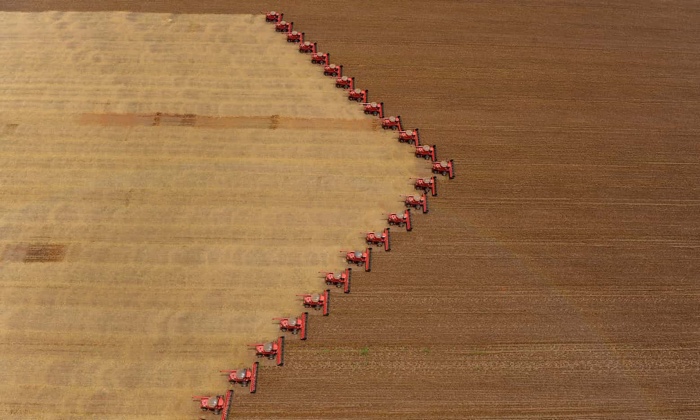
Workers on tractors harvest soybeans in the deforested land of Campo Novo do Parecis, in the Brazilian state of Mato Grosso. Photograph: Maurilio Cheli/AP, via The Guardian
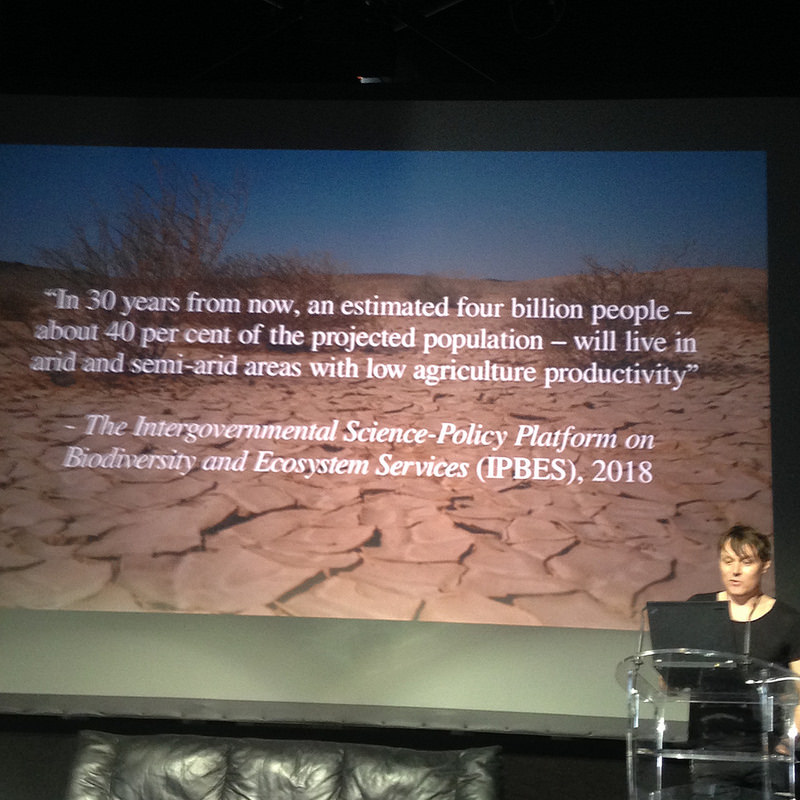
Julian Oliver at Paradigm Shift, Mapping Festival in Geneva
Oliver defied everyone’s expectations by not talking about his artistic work nor any of the issues his presentations usually explore (data forensics, creative hacking, counter-surveillance, etc.) Instead, he gave us a crash course in the Anthropocene: from the 6th extinction (the extent of which the work Extinction Gong reveals in a simple and poignant way) to how our meat-based diet is responsible for 60% of global biodiversity loss; from deforestation to the text World Scientists’ Warning to Humanity: A Second Notice.
His intervention might look at odds with what is usually discussed at digital art festivals but, as his talk also made clear, we can’t disconnect technology from the fate of our planet. To put it in words so blunt even cold-hearted utilitarians would understand, our resources in metals are not infinite (the digital world still relies on a very physical and very energy-hungry infrastructure) and we need insects, animals and plants to perform all sorts of services for us.
Oliver believes that we are in front of a narration challenge when it comes to the ongoing planetary crisis. On the one hand, he quoted, “We’re always preparing for the apocalypse we want” (author unknown). Black Mirror turned this desired apocalypse into dinner table conversations. In the episodes of the scifi series, humans are shown as resilient, cunning and ever resourceful beings.
Techno-centric discourses are not helping either. ‘Reverse climate change” is a delusion, things will not roll back to where things were on earth even if we manage to drop a few degrees back down. Things have already changed. Mass extinction is already well upon us for example.
What we need right now are realistic conversations about the future. They will not have the same feel good effects as techno-fix proposals such as the one that postulates that we only need to suck CO2 from the air in order to stop climate change. These conversations might even be a bit pessimistic but, as Derrick Jensen writes: Hope is what keeps us chained to the system, the conglomerate of people and ideas and ideals that is causing the destruction of the Earth.
Julian Oliver concluded that now is the time for artists and designers to react and embrace planetary crisis as a challenge. We need them to tell stories that would play a key role in propagating a new planetary subjectivity and shape a more realistic, more comprehensive ‘understanding as to how our chains of production and supply interact with both biosphere and climate.’
3. Understanding technology also means being ill-mannered towards it
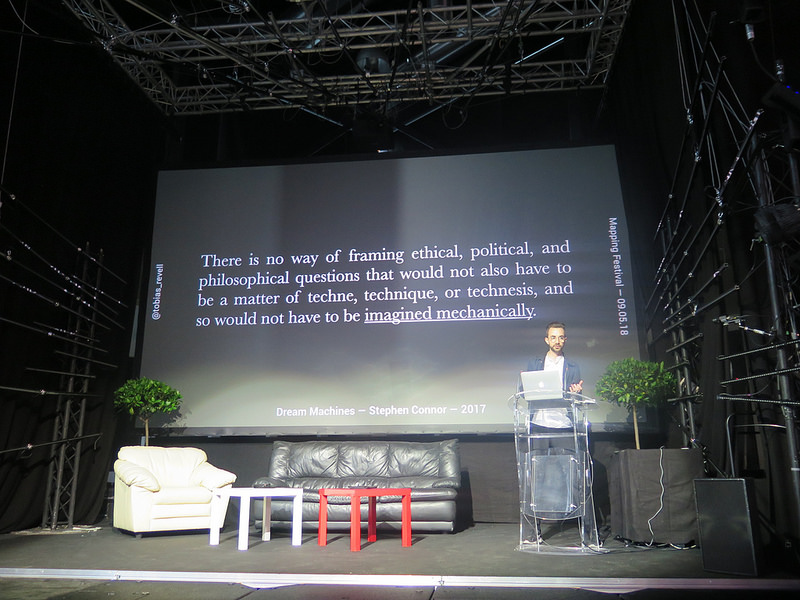
Tobias Revell at Paradigm Shift, Mapping Festival in Geneva
In his contribution to the panel, Tobias Revell made a few fascinating points about using computer-generated imagery (CGI) for purposes that were not intended by the developers. Do check out his talk, it’s packed with interesting insights about strategy of breaking through the technology. I’ll just mention the ones that stuck with me long after the conference:
Nikita Diakur, Ugly Dynamics (Fest), 2018
Ugly Dynamics is a series of works in which Nikita Diakur explores CGI potential to create what he calls the “digital grotesque”. His renderings deconstruct the software and the physics that go into it, breaking apart the engine and revealing how it is made.
As Creative Applications writes: Nikita goes through a number of examples, showing how different dynamics affect models as well as produce very unexpected results. In some cases it is simply because the system doesn’t know how to deal with the set task and in another producing a beautiful result in this alter-reality worlds dictated by these rule based systems.
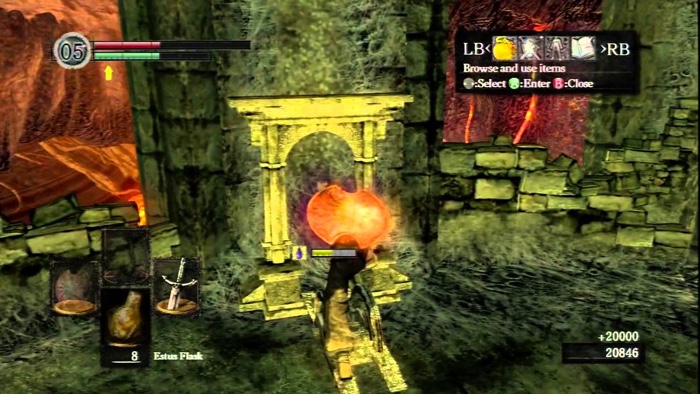
Screenshot from Dark Souls – SPEED RUN (0:26:58) with resets [Xbox 360]
Revell also introduced me to Speedrunning, a huge gaming subculture with videos that can get millions of views. The aim of speedrunning is to complete a video game as fast as possible. You don’t have to complete all the steps in the game, you don’t need to follow the narratives and rules set by the developers, you just have to get to the end as quickly as possible.
Speed runners play with the rules of the architecture that constructs the game, exploiting its glitches, loopholes, frame rate drops, bending the software and hardware to their will. To be a good speedrunner, you don’t need to be a good player. You need to have a nuanced understanding on how the world you live in is built and how it operates.
4. #GLITCHFEMINISM can help us decolonize the architecture of the body
Legacy Russell: URL IRL – Paradigm_Shift #2 Forum – Mapping Festival 2018
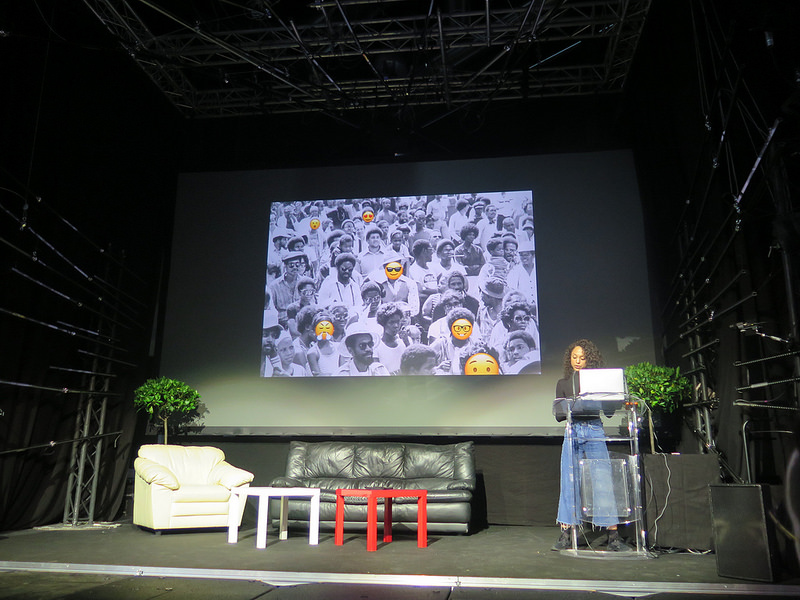
Legacy Russell at Paradigm Shift, Mapping Festival in Geneva
Legacy Russell’s talk ‘URL IRL’ examined Glitch Feminism! Russel is a writer, an artist, a cultural producer and a glitch feminist. She is particularly interested in how the Internet (and the artists activating it) can be harnessed for creative resistance. Glitch Feminism is a cultural manifesto and movement that aims to use the digital as a means of resisting the hegemony of the corporeal. She defines #GLITCHFEMINISM as “a creative and political exploration of how the material the internet can expand -or glitch- the construct of the binary body. it deploys the language of ‘glitch’ in positing that an error within the flawed machine we operate within one that disproportionately enacts violence on historical ‘OTHERED’ bodies – is not an error at all, but rather an integral systems correction to the mechanics of culture and society as we know it.”
Internet is thus a space that asserts the violence against female and queer people and people of colour but it is also a place that allows them to defy and resist that violence.
Her first book ‘Glitch Feminism’ will be published by Verso at the end of the year.
5. Bodies are restless, open and, as such, should dispute the normal
Minds, Bodies and the Machine – Paradigm_Shift #2 Forum – Mapping Festival 2018
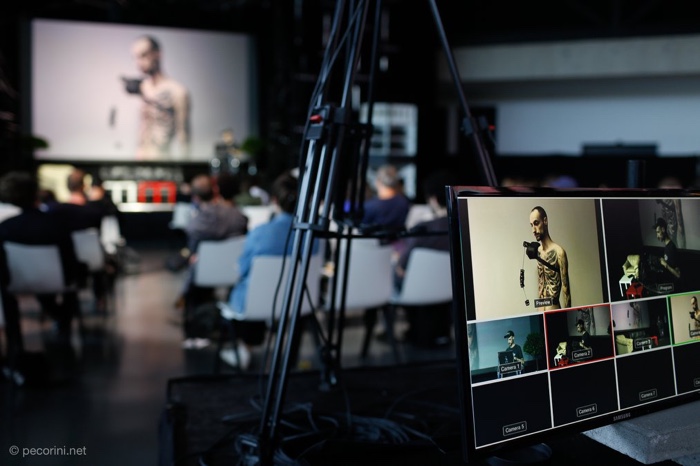
Panel discussion ‘Minds, Bodies and the Machine’ at Mapping Festival 2018 — with Marco Donnarumma at HEAD Genève – Nouveau Campus. Photo (c) Stéphane Pecorini
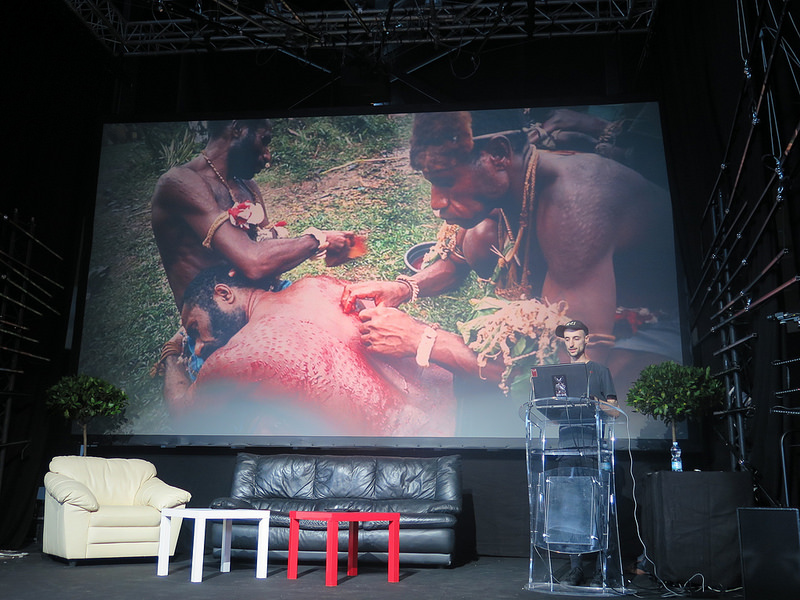
Marco Donnarumma at Paradigm Shift, Mapping Festival in Geneva
The panel on Minds, Bodies and the Machine, moderated by the brilliant Rosario Hurtado, looked at how artists, designers and scientists respond to advances in the field of human-machine-interaction.
Marco Donnarumma, an artist and scholar investigating the relationships between body, sound and technology, kicked his presentation with images of purification rituals called skin cutting and ended up surprising me by adopting a feminist position.
Skin cutting rituals are performed in several parts of the world but the one the artist showed us is performed in Papua New Guinea. Deep cuts are made in the backs, arms, chest and buttocks of young men. The patterns adopted and the method of treating the wounds aim to sculpt the scars so that they remain raised when healed and make the skin look like the one of a crocodile, an animal the Kaningara worship.
The reason why Donnarumma’s practice explores these rituals so closely is that, according to him, they act as a gateway to think about how different societies establish criteria for what constitutes a normal body. In the case of the Kaningara tribesmen from PNG, a ‘standardized’ body allows men to hunt, get married and perform expected roles in society.
The problem with the ‘normal’ is that its definition is generally established by those in power.
Today, we’ve developed different and often more technology-mediated ways to define what’s normal. What hasn’t changed is that, again, the norms of the normal are being prescribed by those in power.
A clear example of that is Hiroshi Ishiguro‘s female android Erica. She is very pretty, very young, she is slim, has big lips, smooth skin and a fine nose. She is the epitome of a woman built by a man. What is regarded as normal for woman is thus reinforced by technology, disseminated in media and ends up being what our kids identify as being normal.
That’s why Donnarumma’s work explores alternative forms of embodiment. By creating tangible speculations about what different bodies can be, he hopes that something will be triggered in the mind of the viewers and that it will open gates onto ideas and counter cultures able to untie what we regard as normal.
Over the past 4 years, he has been working on what he calls “configurations” which are various types of assemblages of humans and machines.
Marco Donnarumma, Amygdala MK3
His Amygdala work for example is and artificially intelligent robotic limb that has been programmed to perceive its own body, respond to unforeseen reactions from others and cut its own skin, in a way inspired by the purification ritual of “skin-cutting”.
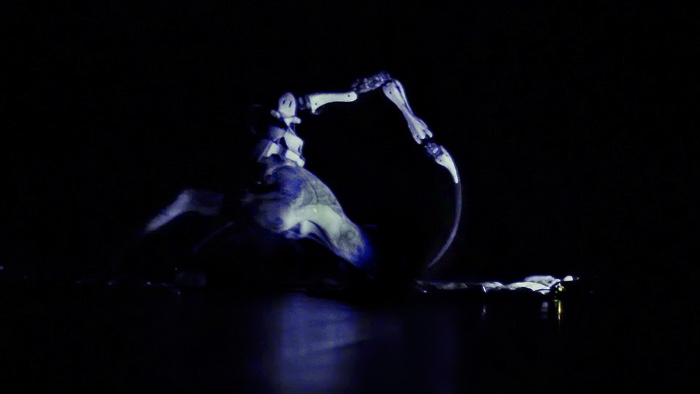
Marco Donnarumma, Eingeweide, a work in progress
The next step for Amygdala is to be part of Eingeweide, a ritual of coalescence in which the machine is attached to the artist’s body for a performance during which the two of them are searching for their own joint, bodily identity, a process which makes the distinction between them, between flesh and circuits, muscles and wires blurred and undefined.
For Donnarumma, it is important to abuse technology and use it to destroy traditional ideas of what constitutes the normal.
During the short debate at the end of the panel, he also had a few meaningful words about the necessity to think about who owns the tech that will change our bodies.
More images from Forum Paradigm_Shift #2:
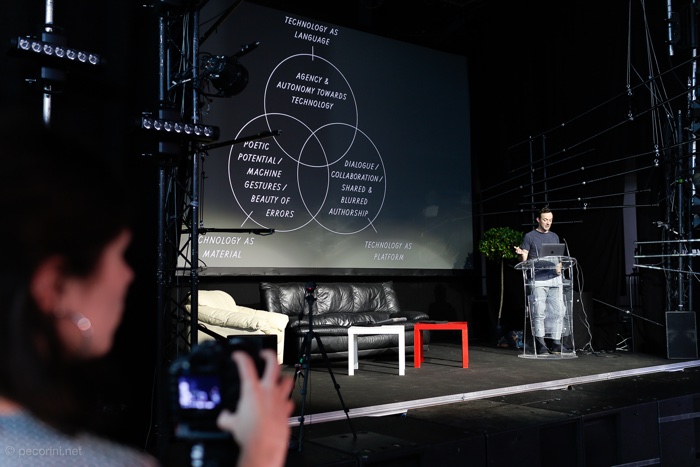
‘Minds, Bodies and the Machine’ at Mapping Festival 2018 — with Jürg Lehni, at HEAD Genève – Nouveau Campus. Photo (c) Stéphane Pecorini
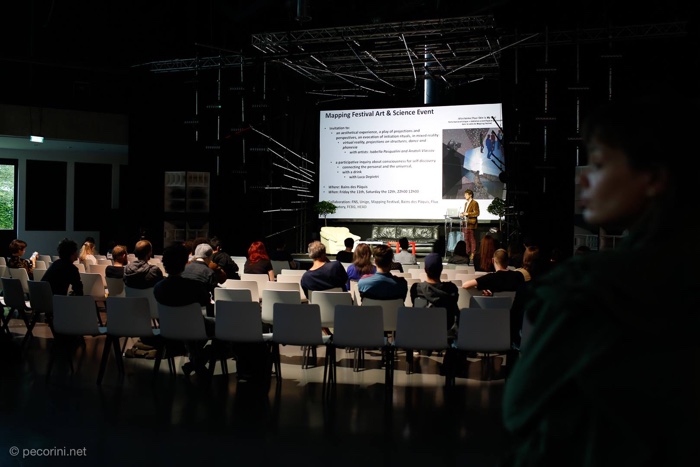
Minds, Bodies & The Machine panel discussion with Prof. David Rudrauf. Photo (c) Stéphane Pecorini
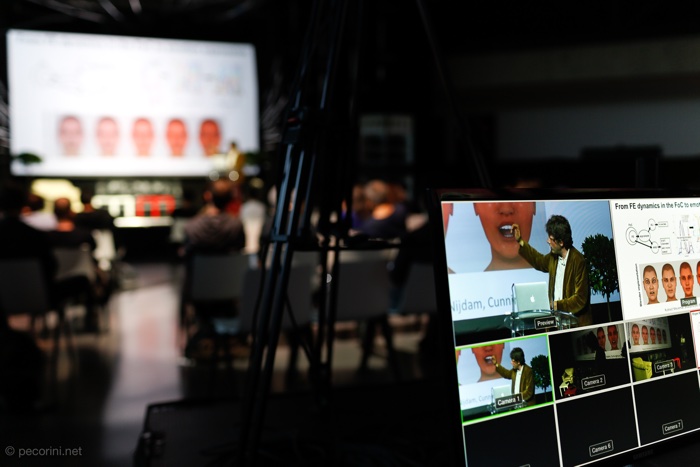
‘Minds, Bodies and the Machine’ at Mapping Festival 2018 — with Prof. David Rudrauf, at HEAD Genève – Nouveau Campus. Photo (c) Stéphane Pecorini
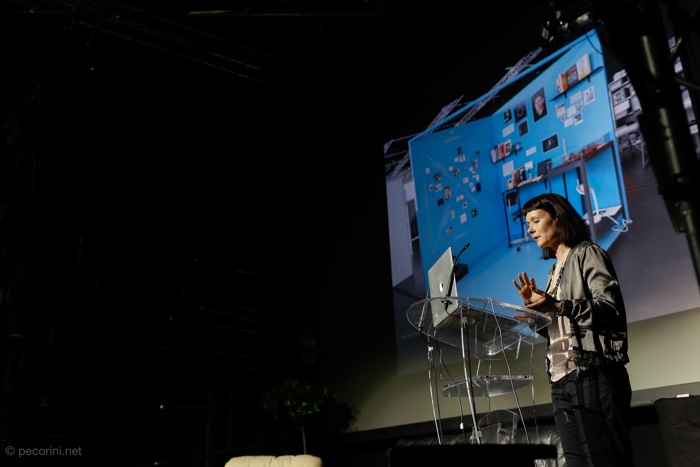
‘Minds, Bodies and the Machine’ at Mapping Festival 2018 — with Susanna Hertrich at HEAD Genève – Nouveau Campus. Photo (c) Stéphane Pecorini


